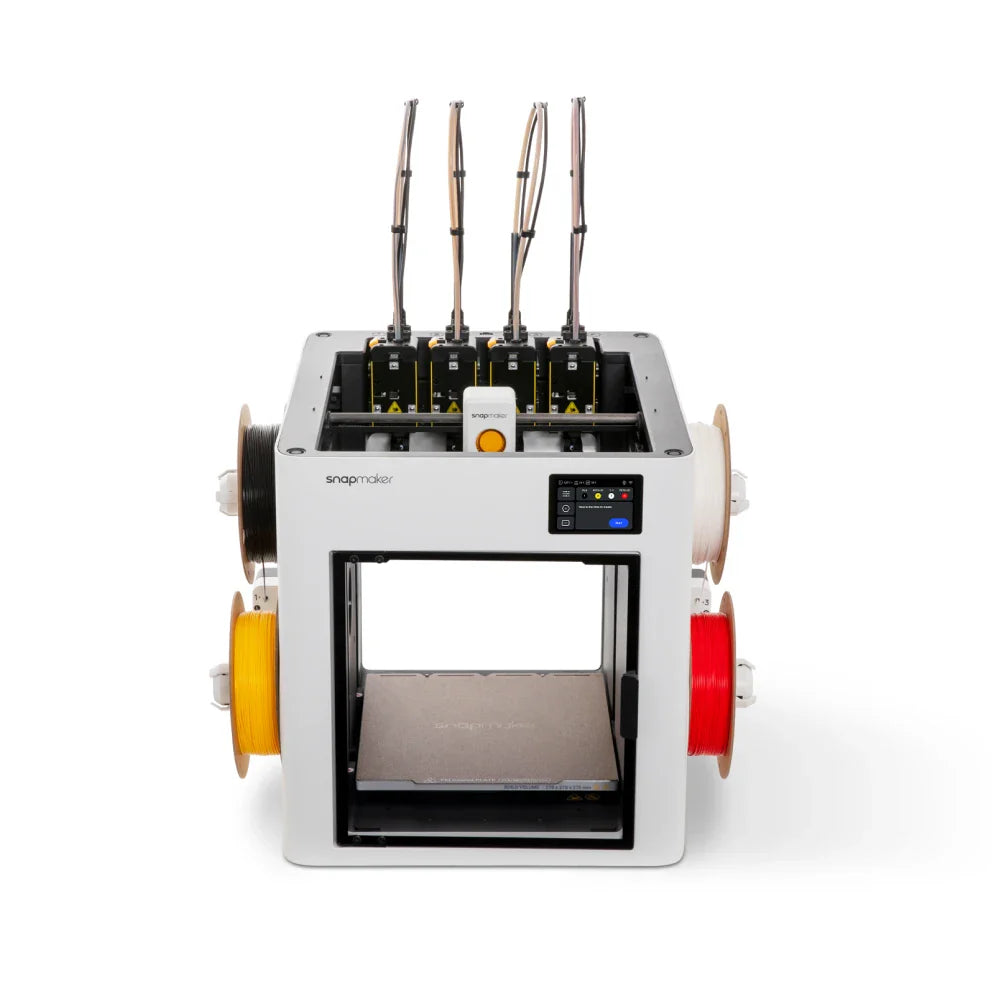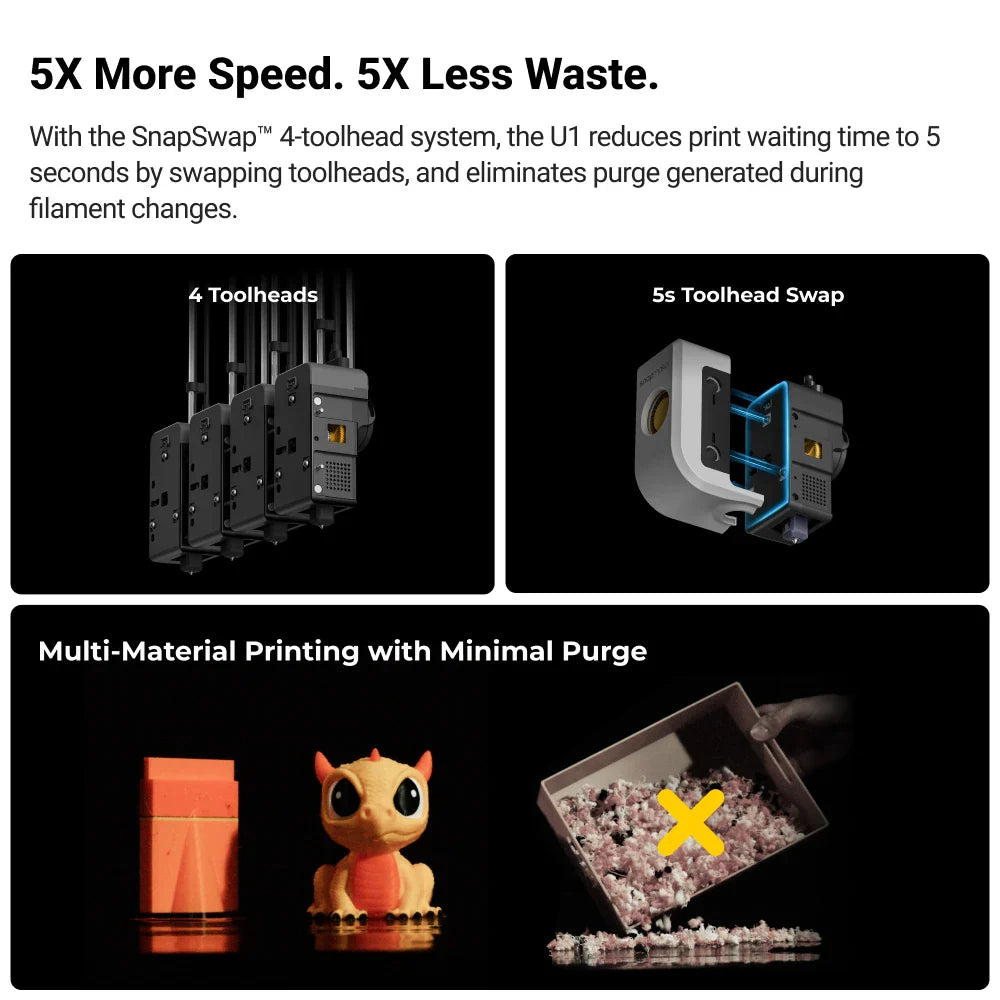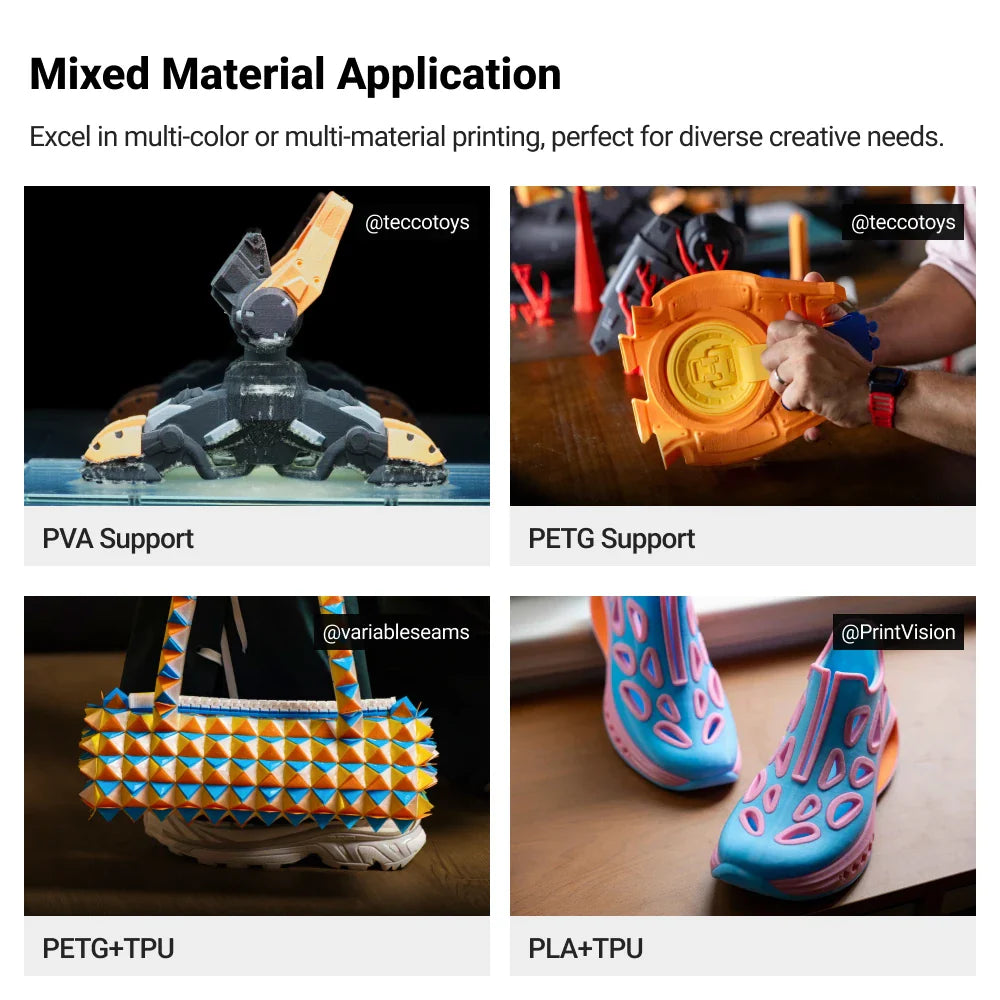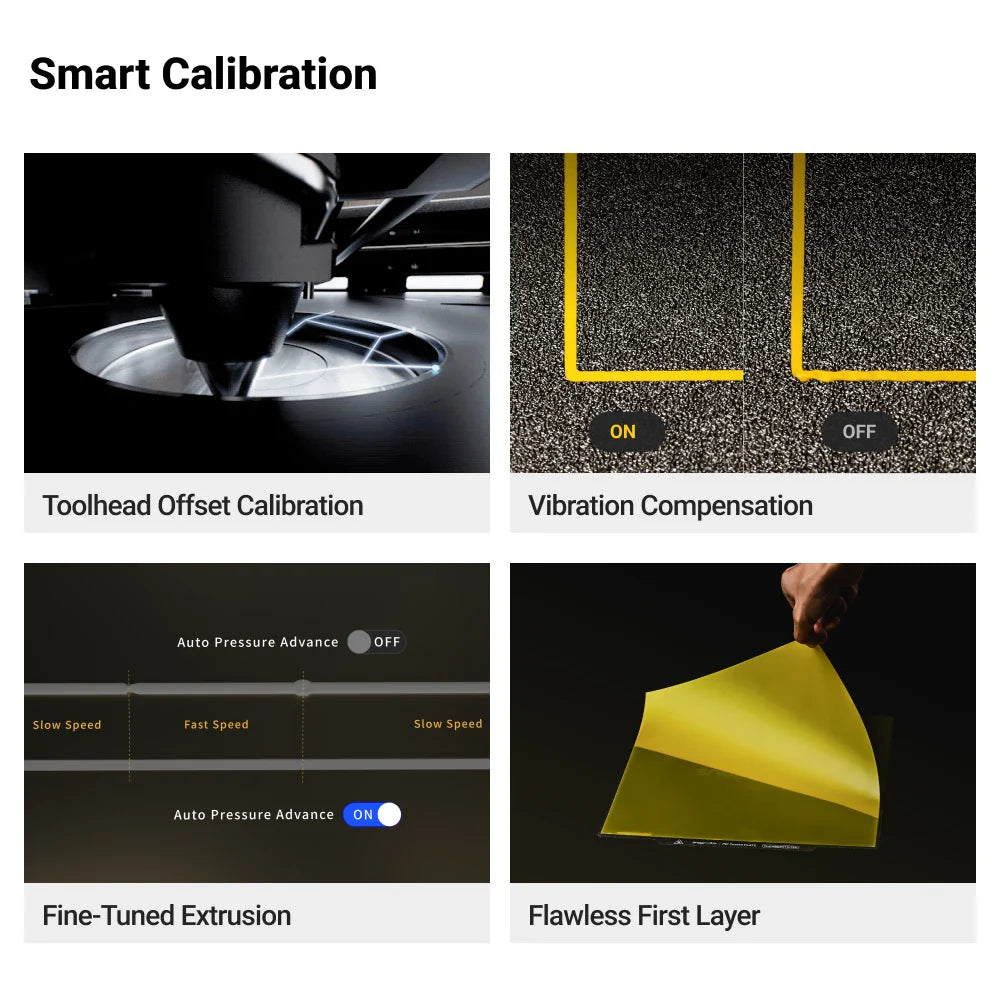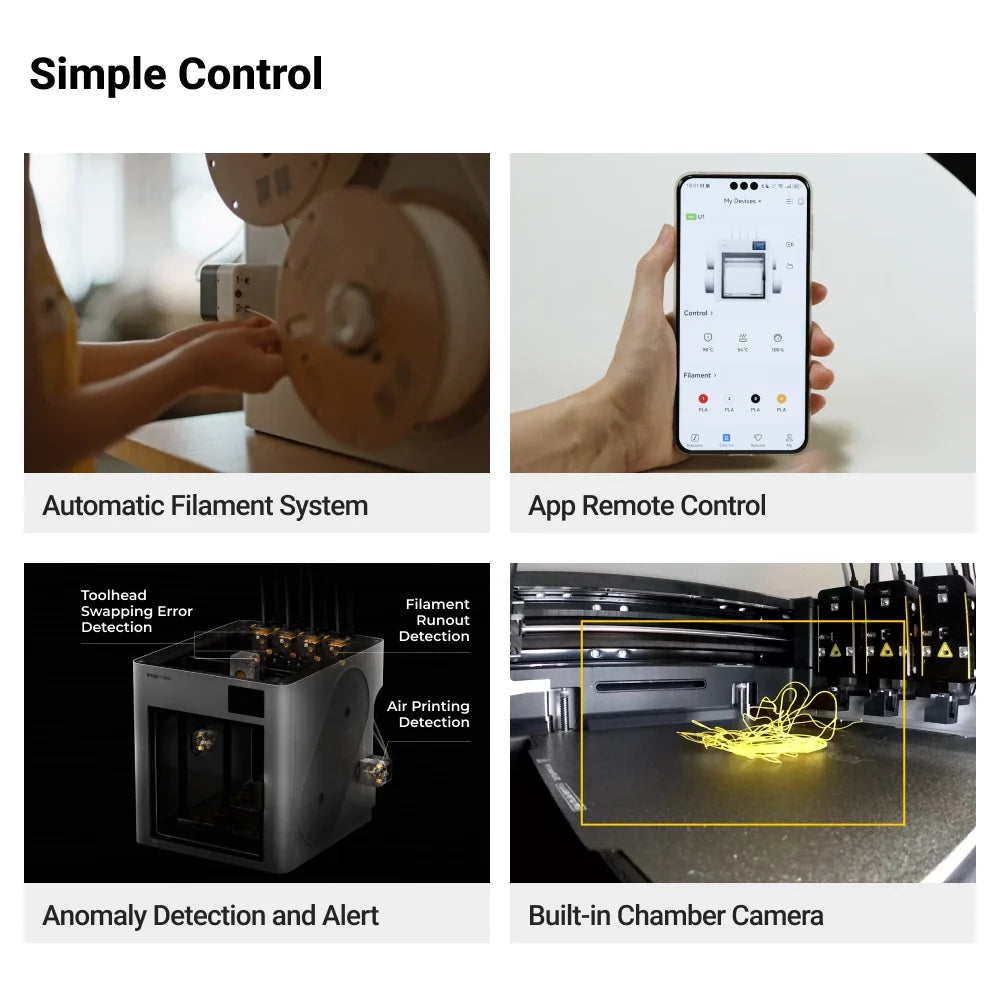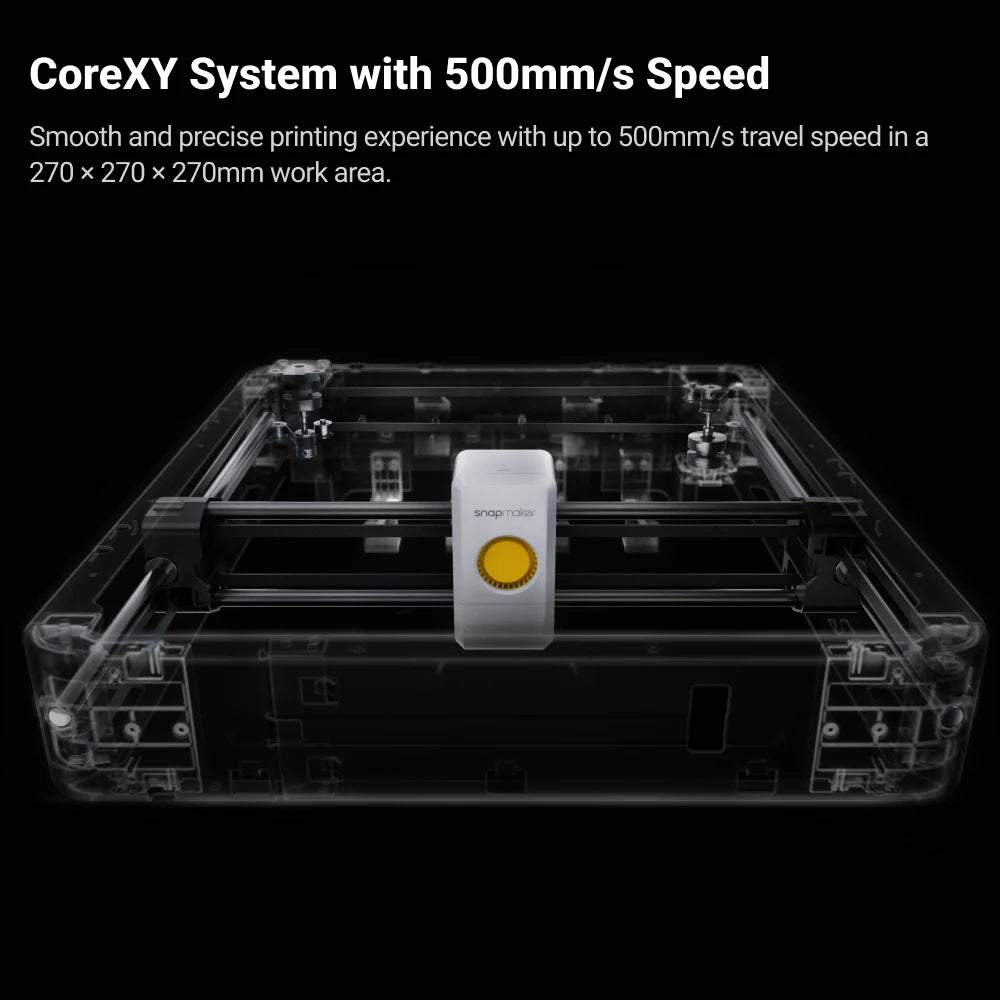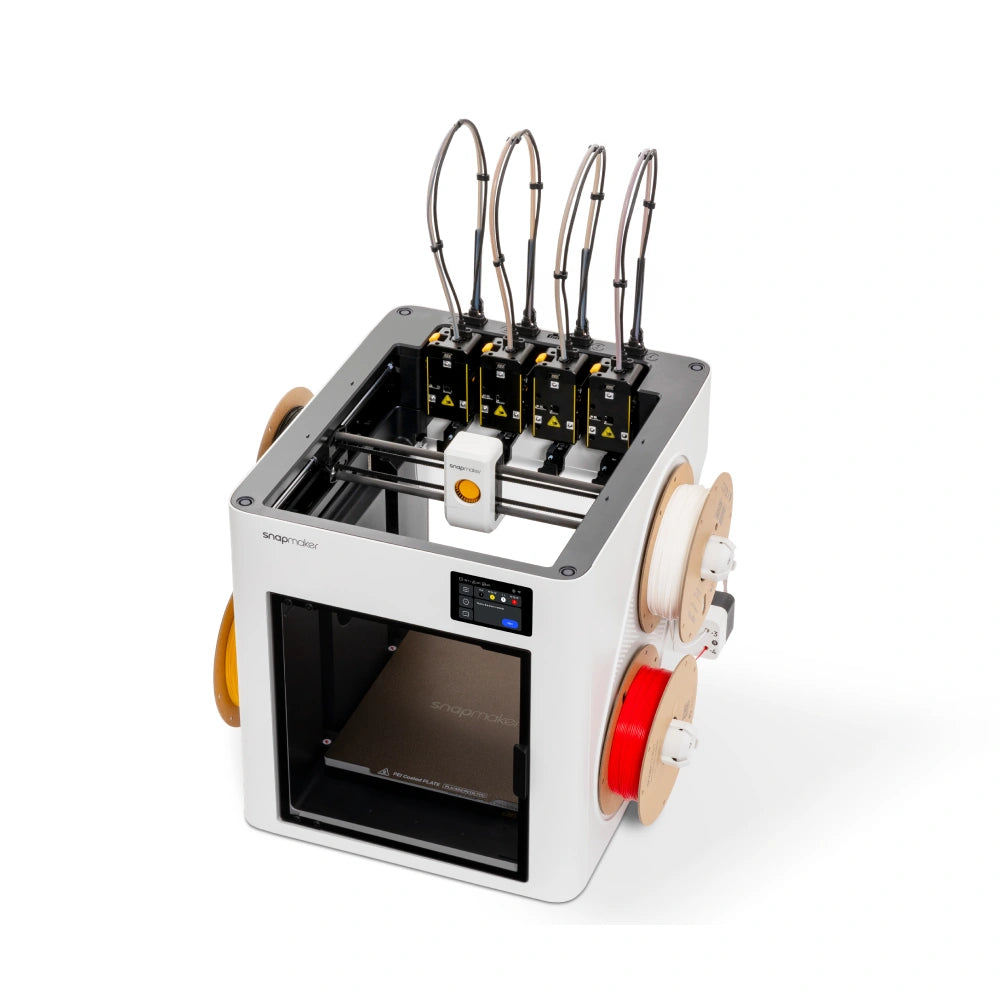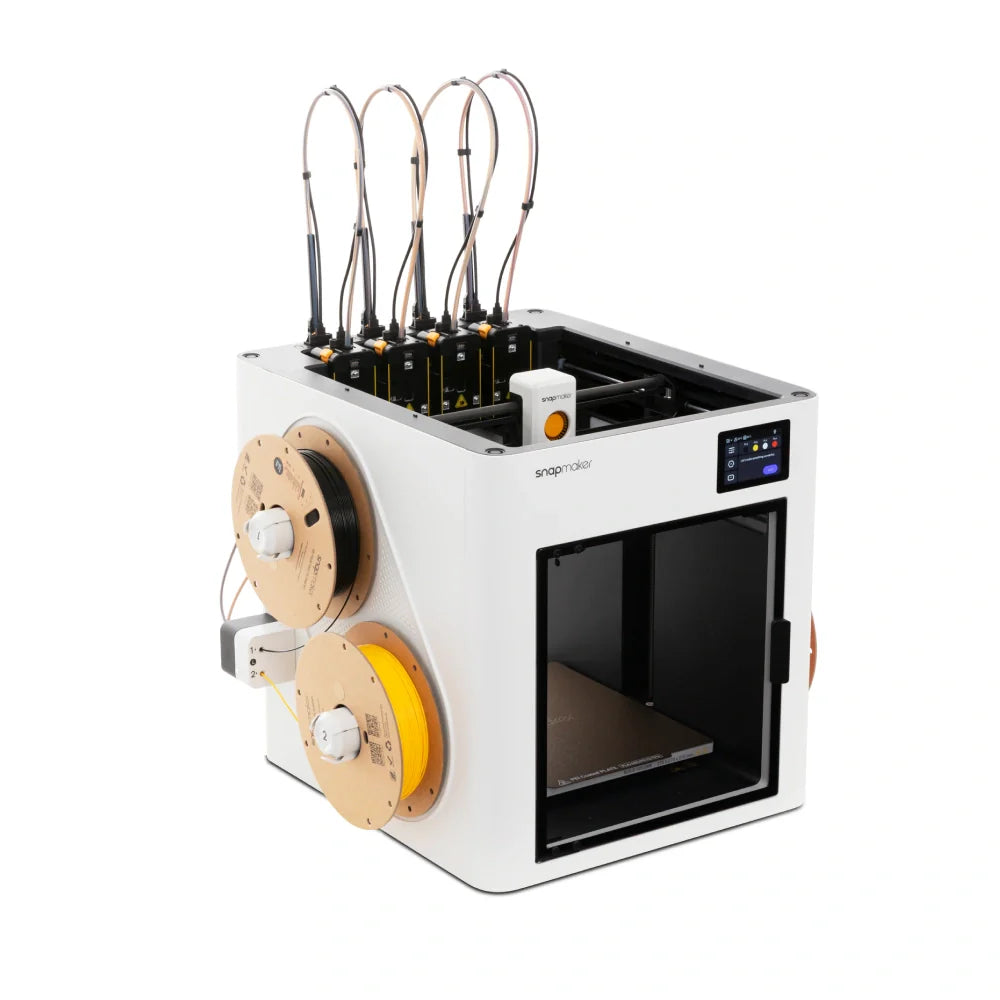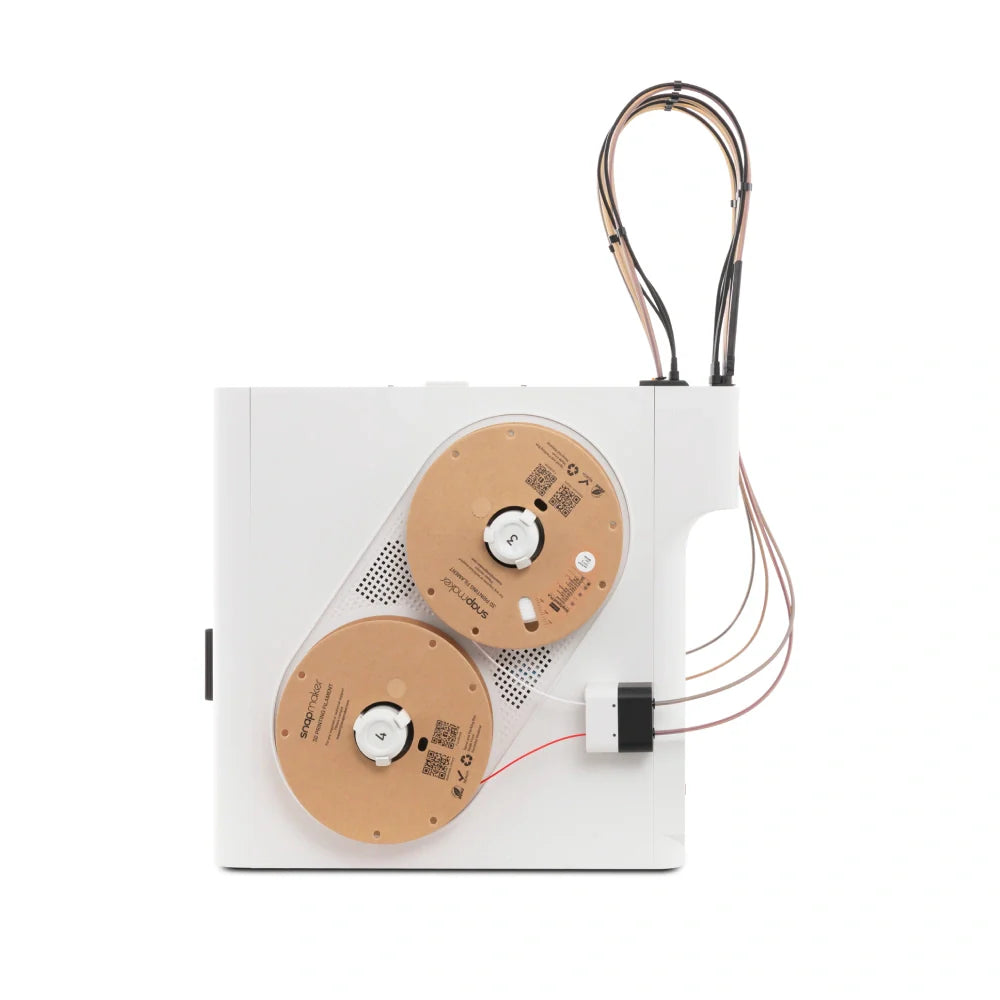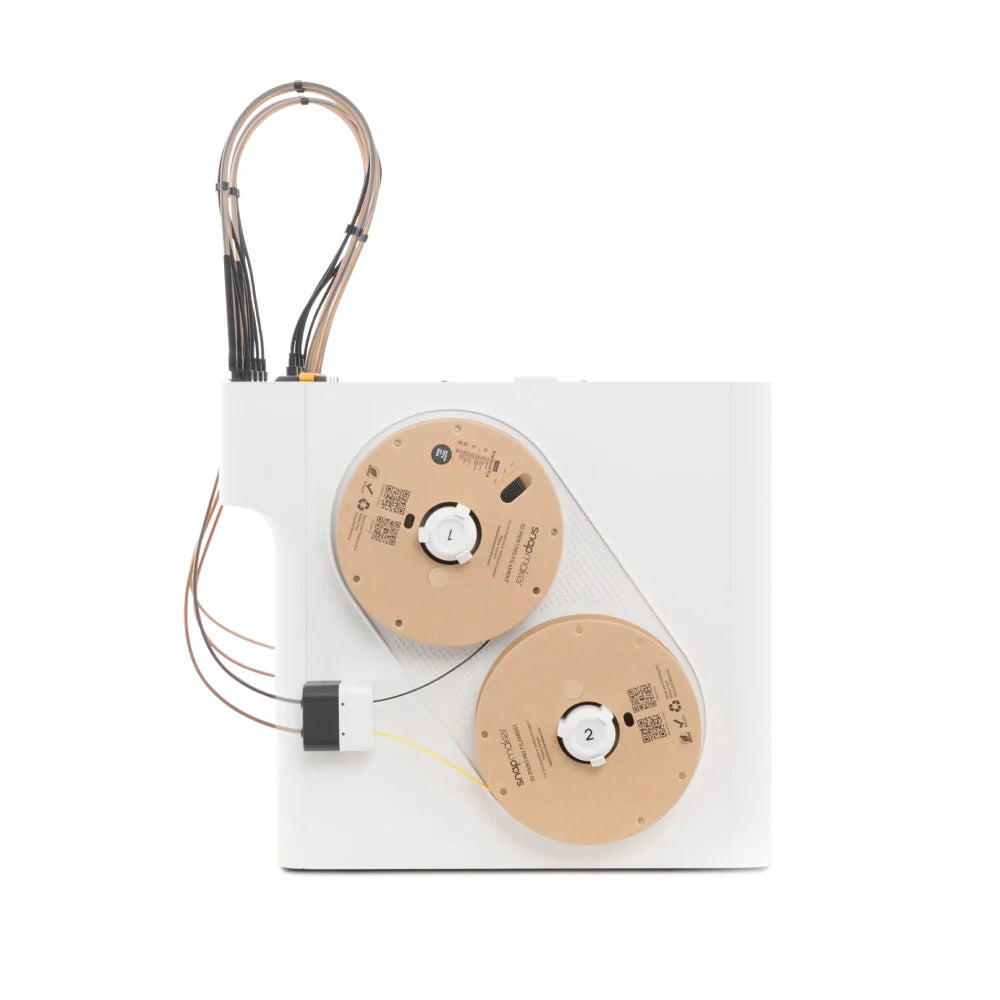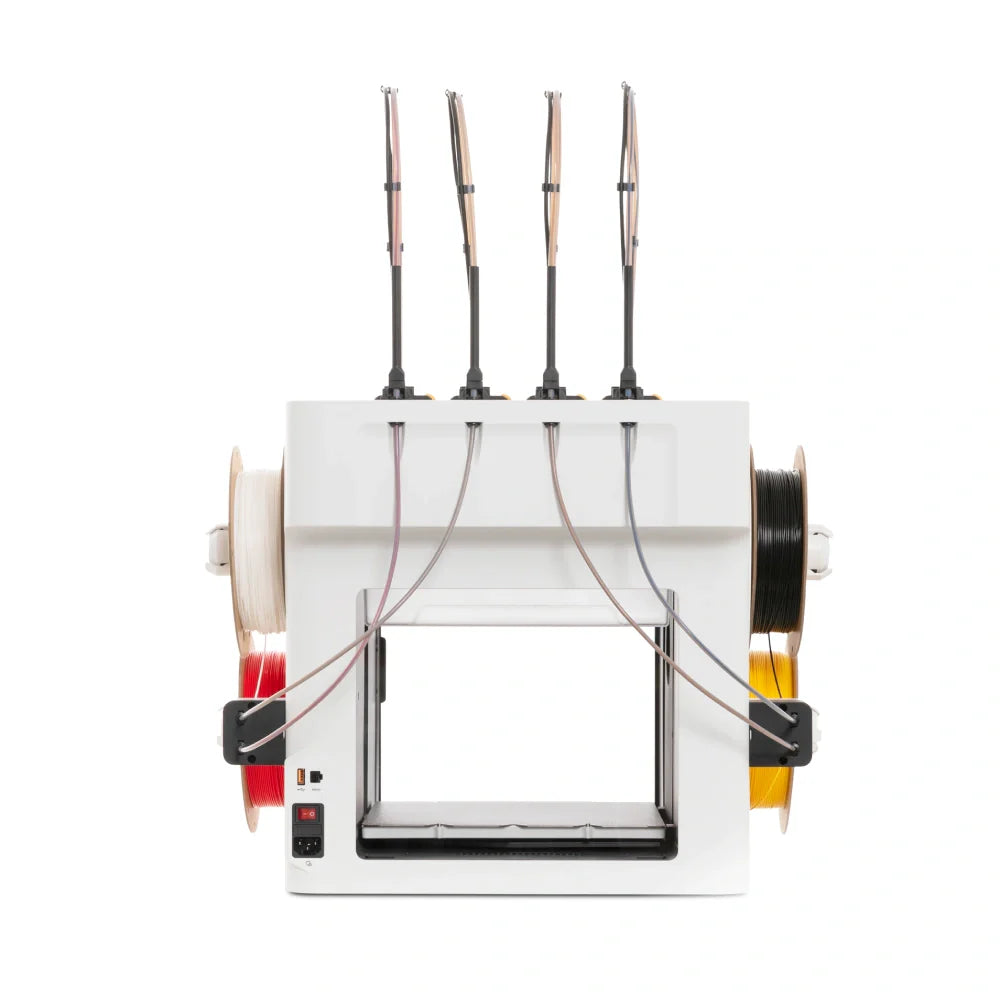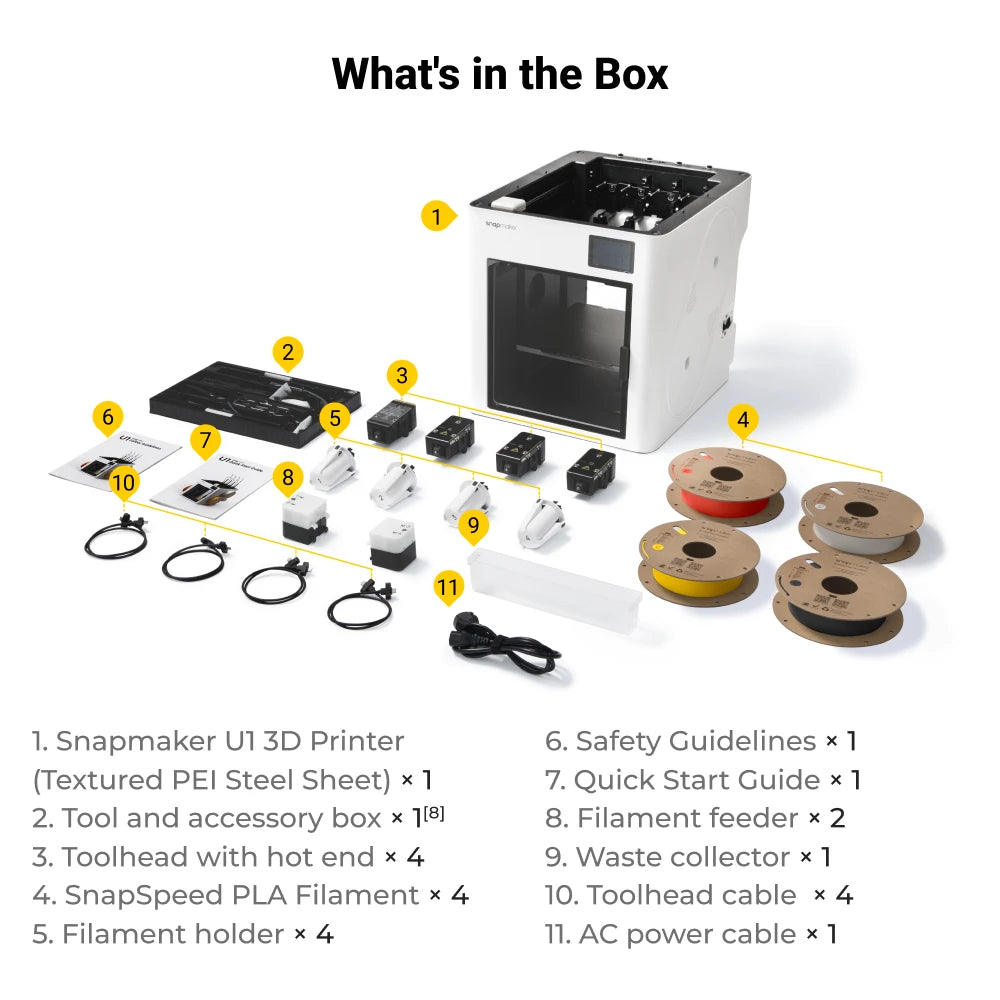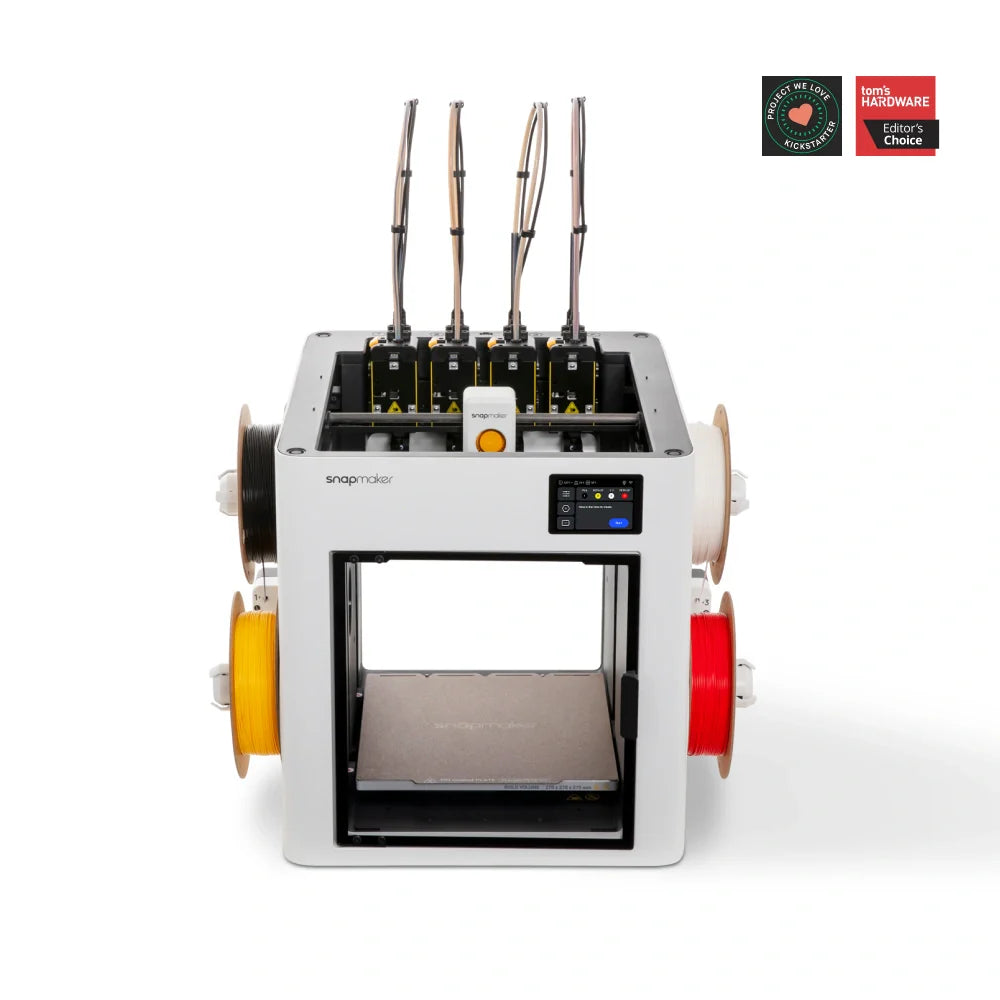Product Overview
• SnapSwap™ System: With 4 toolheads preloaded and pre-heated materials, U1 cuts waiting time to 5 seconds by swapping toolheads, and eliminates remaining material squeezing out for filament changes, enabling 5X more speed and 5X less waste.
• Multiple Colors and Materials: 4 individual extruders enable printing creations with multi-color, multi-material filaments, unleashing your creativity.
• Smart Calibration: Dynamic flow calibration, vibration compensation, fine-tuned extrusion, and flawless first layer.
• CoreXY System with 500mm/s Speed: Lightweight, rigid carbon fiber X-axis rails, delivering travel speeds of up to 500mm/s, and maintaining long-term precision across a 270 × 270 × 270mm work area.
• Ease of Use: Automatic filament system, AI-powered print monitoring and smart control, such as 3.5-inch touchscreen, App remote control, and software Snapmaker Orca.
Note: The AI-related function will be added by December 2025 through an OTA firmware update.
Snapmaker U1 3D Printer

Featured RFID Filament
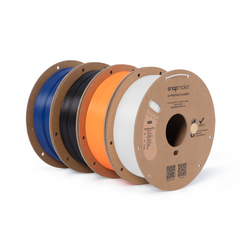
SnapSpeed PLA Filament Bundle (RFID)
€64,00 €109,00

Matte PLA Filament (1kg)
€22,90 €23,99

SnapSpeed PLA Filament (1kg)
€22,90 €26,99
Featured Add-ons & Accessories

Top Cover for Snapmaker U1
€159,00 €269,00

Hot End for Snapmaker U1
€54,00 €89,00

SnapDryer Bundle
€129,00 €179,00

PEI Steel Sheet for Snapmaker U1
€27,99 €39,99

Graphic Effect Steel Plate for Snapmaker U1
€24,99 €33,99

Nozzle Cleaning Brushes & Parking Pads Kit for Snapmaker U1
€4,99

Hot End Silicone Sock 4-Pack for Snapmaker U1
€4,99
Supported Payment Methods
Supported Payment Methods
For pre-order products, we accept PayPal, credit/debit cards, Apple Pay, and Google Pay. Installment payments are currently not supported.
Shipping & Tax Information
Shipping & Tax Information
€50 shipping fee per U1.
Prices include VAT.
- Features
- Specification & Parts
Frequently Asked Questions
1. Does Snapmaker support trade-in?
Currently, Snapmaker does not offer a trade-in option. However, we ensure peace of mind with a limited warranty covering major modules of Snapmaker 3D Printer purchased directly from us or through an authorized distributor. For detailed information and to enhance your shopping experience, please review our warranty policy.
2. If I purchase the Artisan 3-in-1 3D Printer(Premium), do I also need to purchase the Boosted Exhaust Fan?
There's no need to buy a separate exhaust fan; the Artisan 3-in-1 3D Printer (Premium) already includes a Boosted Exhaust Fan. With a powerful airflow capacity of 95CFM, this fan effectively removes smoke and fumes, ensuring a cleaner and safer printing environment.
3. Is a quick swap toolhead plate included with the purchase of the Artisan 3-in-1 3D Printer (Premium)?
Yes, the Artisan 3-in-1 3D Printer (Premium) comes equipped with the quick swap toolhead plate, which allows for adjustable tightness between the toolhead bracket and the toolhead plate for seamless operation and customization.
4. How are Snapmaker Artisan and Snapmaker 2.0 compatible with other modules and addons?
5. Should I choose the Artisan 3-in-1 3D Printer or three separate machines for 3D printing, CNC milling, and laser engraving?
Opting for the Snapmaker Artisan offers significant benefits if you prioritize a streamlined workflow and space efficiency. This all-in-one machine combines advanced 3D printing, CNC milling, and laser engraving in a single, compact unit. Its modular design allows for quick and easy switching between functions, maximizing both time and space. Equipped with high-precision components like a dual-nozzle printer and a powerful laser module, the Artisan ensures top-quality outputs across various tasks, making it an excellent choice for those seeking versatility without the spatial demands of multiple devices.
6. What safety mechanisms are in place during laser operations on the Artisan 3-in-1 3D Printer?
We embedded a door-detection sensor in the Enclosure, a gyro sensor and temperature sensor in the Laser module, Emergency Stop Button in the Integrated Controller. Your safety is in good hands.
7. How does the dual extruder function enhance 3D printing on the Snapmaker Artisan?
The dual extruder allows for printing with two different colors or materials simultaneously, ideal for creating complex models with support structures or multi-colored objects.
Specifications
General
Dimensions
584mm × 499mm × 730mm
Build Volume
270mm × 270mm × 270mm
Weight
18.2kg
Printing Properties
Printing Technology
Fused Deposition Modeling
Build Volume
584mm × 499mm × 730mm
Max Toolhead Speed
500mm/s
Max Acceleration Speed
20,000mm/s²
Toolhead
Toolheads Included
Fused Deposition Modeling
Max Flow for Hot End
584mm × 499mm × 730mm
Nozzle
18.2kg
Max Nozzle Temperature
18.2kg
Nozzle
18.2kg
Nozzle
18.2kg
Nozzle
18.2kg
- Features
- Specification & Parts
Meet Snapmaker U1
Make More, Waste Less
Perspectives from Pros
Creative Vibes, Uplifted by U1
Whether you're bonding over colorful creations at home, building your ultimate hobby hub, or adding a clever twist to your everyday style, the U1 makes it all effortless and fun.
- Home Use & Toys
- Hobby & DIY
- Fashion & Art
Switch Filaments in 5 Seconds with SnapSwap™
Most printers rely on filament changers to switch between colors or materials, spending more time purging than actually printing. With four toolheads preloaded and pre-heated with their own filaments, the SnapSwap™ system lets the U1 switch by simply swapping the toolheads, cutting your wait time from approximately two minutes to only five seconds[2].
Switch Filaments in 5 Seconds with SnapSwap™
Most printers rely on filament changers to switch between colors or materials, spending more time purging than actually printing. With four toolheads preloaded and pre-heated with their own filaments, the SnapSwap™ system lets the U1 switch by simply swapping the toolheads, cutting your wait time from approximately two minutes to only five seconds[2].
No More Purging for Color Change
Filament-changing printers "purge" by wasting perfectly good filament—pushing one color through the nozzle until the last trace of the old one is gone. The U1 doesn't play that game. It only purges the tiny amount of filament that's actually degraded by the time a new print job begins, or during flow-rate calibration, cutting waste by up to 80%[3] on every print.
Rock-Solid & Precise Locks
The U1 uses steel-ball kinematic couplings to click each print heat into perfect position, then locks it securely—no screws, no magnets, no extra motors. Locked fast, rock solid, tested over 1,000,000 swaps with zero failures.
No More Purging for Color Change
Filament-changing printers "purge" by wasting perfectly good filament—pushing one color through the nozzle until the last trace of the old one is gone. The U1 doesn't play that game. It only purges the tiny amount of filament that's actually degraded by the time a new print job begins, or during flow-rate calibration, cutting waste by up to 80%[3] on every print.
Rock-Solid & Precise Locks
The U1 uses steel-ball kinematic couplings to click each print heat into perfect position, then locks it securely—no screws, no magnets, no extra motors. Locked fast, rock solid, tested over 1,000,000 swaps with zero failures.
Less Waste Means Serious Savings
So. Much. Waste. On other 3D printers, printing a multi-color model leaves behind a mountain of garbage—often wasting 3 or 4 times more material than what ends up in the actual model! U1 avoids the waste with smart tool swapping, saving filament, saving money, and even saving the environment.
How Much Can You Save in a Year?
* “Others” refers to 3D printers that use a filament changer to swap materials.
* Based on PLA filament at an average cost of $15/kg, with a printing frequency of one piece per week.
Pick Your Material Pairs
With four independent extruders, the U1 lets you mix and match materials freely, giving each part its own function, or making support removal a breeze with low-adhesion combos.
Mix Materials for Easy-to-Remove Supports
- PETG Support
- PVA Support
With 4 toolheads, U1 prints stable PETG components to support your creation safely, avoiding mid-print warping. These supports are easy to detach without damage, so you can skip tedious prying and keep your finished prints intact.
PVA is costly but necessary for some creations. U1's 4-toolhead system minimizes purges to little or zero, so you can pair PVA with other materials freely, reduce waste greatly, and save money dramatically!
Blend Rigid and Flexible Materials
- PETG+TPU
- PLA+TPU
With 4 individual extruders, you can match flexible TPU and rigid PETG together, print more creative artwork such as a 3D printed hand bag.
Smooth Print Starts with Smart Calibration
With four toolheads working at high speed, precision isn’t optional—it’s built in. The U1's compensation algorithms lock every toolhead in sync, dampen vibrations, dial in extrusion, and level out the build surface, so you get the smooth, dimensionally accurate results you’d expect from a top-tier single-head printer.
Toolhead Offset Calibration
U1 automatically aligns each toolhead with the main nozzle, holding offset under 0.04mm[4] to ensure sharp prints without vertical shifts.
Toolhead Offset Calibration
The U1 automatically aligns XYZ offsets between multiple toolheads, keeping offsets within 0.04mm[5] for sharp prints without vertical shifts.
Vibration Compensation for Consistent Prints
Input Shaping, aided by a precision accelerometer sensor, reduces vibrations caused by rapid directional changes by pre-processing movement commands to cancel out resonant frequencies. By adjusting acceleration profiles and introducing calculated delays, it prevents surface artifacts like ghosting or ripples, allowing the U1 to deliver clean edges, smooth walls, and sharp details even at high speeds.
Vibration Compensation for Consistent Prints
Input Shaping, aided by a precision accelerometer sensor, reduces vibrations caused by rapid directional changes by pre-processing movement commands to cancel out resonant frequencies. By adjusting acceleration profiles and introducing calculated delays, it prevents surface artifacts like ghosting or ripples, allowing the U1 to deliver clean edges, smooth walls, and sharp details even at high speeds.
Fine-tuned Extrusion for Exquisite Details
The U1 uses Pressure Advance to stay ahead of flow delays, especially during quick moves or sharp corners. It tweaks extrusion timing based on motion changes, so filament flows smoothly even when speeds shift. That means fewer blobs, less thinning, and crisp, consistent detail.
Fine-tuned Extrusion for Exquisite Details
U1 uses pressure advancThe U1 uses Pressure Advance to stay ahead of flow delays, especially during quick moves or sharp corners. It tweaks extrusion timing based on motion changes, so filament flows smoothly even when speeds shift. That means fewer blobs, less thinning, and crisp, consistent detail.
The First Layer Matters Too
The automatic mesh bed leveling delivers a flat, grippy first layer, setting the stage for every print.
The First Layer Matters Too
The automatic mesh bed leveling delivers a flat, grippy first layer, setting the stage for every print.
Effortless Filament Management
The U1 comes equipped with a super-compact automatic filament system that holds up to four spools on standby. It handles everything from filament detection and loading, so you can print in vivid color, hassle-free.
- Auto-loading
- Backup Mode
- RFID Recognition
Auto-loading
No more threading, fiddling, or guesswork. Just hang your filament and let it roll.
Backup Mode
When Backup Mode is on, U1 automatically switches to a matching spool when one runs out, so you'll never stress over what to do with those almost-empty rolls.
RFID Recognition
U1 uses RFID to detect specs like color, type, and more for Snapmaker official filaments, no need to type anything in.
Manage Your Prints with Ease
Snapmaker Orca builds on Orca Slicer’s powerful engine and adds engineer-tested profiles for official materials and machine models. Paired with the Snapmaker App, you can start, monitor, and control your prints from anywhere—and even capture 2. time-lapse videos to replay your creation in motion. Easy print management is right at your fingertips.
- Snapmaker APP
- Snapmaker Orca
- 3.5-inch Touchscreen
Anomaly Detection and Alert
With a mix of over a dozen sensors and precision mechanics, the U1 automatically spots issues and guides you through quick fixes, ensuring smooth, successful prints every time.
Capture the Highlights, Skip the Messes
The built-in chamber camera isn’t just for time-lapses. Starting with an OTA firmware update planned for December 2025 [5], its AI will detect spaghetti and workspace obstructions and alert you in Snapmaker Orca or the app, helping you avoid wasted time and material.
CoreXY System with 500mm/s Speed
The U1 is built on a CoreXY motion system with lightweight, rigid carbon fiber X-axis rails, delivering speeds of up to 500mm/s and maintaining long-term precision across a 270 × 270 × 270mm work area.
How the U1 Is Built and Tested
Snapmaker machines are built for excellence, as our longtime users know very well. From careful assembly to rigorous lab testing, each unit is crafted for the reliability, consistency, and creative freedom you've come to expect.
How the U1 Is Built and Tested
Snapmaker machines are built for excellence, as our longtime users know very well. From careful assembly to rigorous lab testing, each unit is crafted for the reliability, consistency, and creative freedom you've come to expect.
Specifications
General
Dimensions2
584mm × 499mm × 730mm
Weight
18.2kg
Printing Properties
Printing Technology
Fused Deposition Modeling
Build Volume
270mm × 270mm × 270mm
Max Toolhead Speed
500mm/s
Max Acceleration Speed
20,000mm/s²
Toolhead
Toolheads Included
4
Max Flow for Hot End
32mm³/s[6]
Nozzle
Stainless Steel
Max Nozzle Temperature
300°C
Nozzle Diameter
0.4mm
Filament Diameter
1.75mm
Part Cooling
Main & Auxiliary Part Cooling Fans
Heated Bed
Build Plate
Flexible Steel Sheet with PEI Surface
Max Heated Bed Temperature
100°C
Supported Filament Type
Basic Material Compatibility
PLA, PETG, TPU, PVA, PCTG
With Optional Top Cover
PLA, PETG, TPU, PVA, PET, ABS, ASA, PA, PC
With Top Cover & Hardened Steel Nozzle
PLA, PETG, TPU, PVA, PET, ABS, ASA, PA, PC, Carbon-fiber-reinforced Polymer, Glass-fiber-reinforced Polymer
Electronics
Touchscreen
3.5-inch 320 × 480 Touchscreen
Data Transmission Methods
Wi-Fi (IEEE802.11b/g/n Standards, 2.4GHz), USB Flash Drive
Storage
26 GB eMMC
Live View Camera
2 Megapixel Built-in Chamber Camera
Max Input Power
1150 W (220-240 V~), 400 W (100-120V~)
Max Input Current
6 A(220-240V~), 4 A(100-120 V~)
Auto-calibration
Heated Bed Leveling
Mesh Bed Leveling
Active Vibration Control
Accelerometer & Input Shaping Calibration
Automatic Flow Compensation
Pressure Advance Calibration
Automatic Toolhead Offset Calibration
Coordinate Measuring Calibration
Automatic Filament System
Auto-feed
Supported
Backup Mode
Supported
Filament RFID Recognition
Supported
Failure Detection
Air Printing Detection
Supported
Filament Run Out Detection
Supported
Power Loss Recovery
Supported
Anomaly Detection
Toolhead Swap Error Detection
Supported
Build Plate Presence Detection
Supported
Build Plate Obstruction Detection
Supported
Software
Supported Slicer
Snapmaker Orca, Orcaslicer
APP
Snapmaker APP
Operating System
Software
Windows, macOS, Linux
APP
Android, iOS
Firmware
Firmware
Klipper
Specifications
General
Dimensions
584mm × 499mm × 730mm
Build Volume
270mm × 270mm × 270mm
Weight
18.2kg
Printing Properties
Printing Technology
Fused Deposition Modeling
Build Volume
584mm × 499mm × 730mm
Max Toolhead Speed
500mm/s
Max Acceleration Speed
20,000mm/s²
Toolhead
Toolheads Included
4
Max Flow for Hot End
32mm³/s[6]
Nozzle
Stainless Steel
Max Nozzle Temperature
300°C
Nozzle Diameter
0.4mm
Filament Diameter
1.75mm
Part Cooling
Main & Auxiliary Part Cooling Fans
Heated Bed
Build Plate
Flexible Steel Sheet with PEI Surface
Max Heated Bed Temperature
100°C
Supported Filament Type
Basic Material Compatibility
PLA, PETG, TPU, PVA, PCTG
With Optional Top Cover
PLA, PETG, TPU, PVA, PET, ABS, ASA, PA, PC
With Top Cover & Hardened Steel Nozzle
PLA, PETG, TPU, PVA, PET, ABS, ASA, PA, PC, Carbon-fiber-reinforced Polymer, Glass-fiber-reinforced Polymer
Electronics
Touchscreen
3.5-inch 320 × 480 Touchscreen
Data Transmission Methods
Wi-Fi (IEEE802.11b/g/n Standards, 2.4GHz), USB Flash Drive
Storage
26 GB eMMC
Live View Camera
2 Megapixel Built-in Chamber Camera
Max Input Power
1150 W (220-240 V~), 400 W (100-120V~)
Max Input Current
6 A(220-240V~), 4 A(100-120 V~)
Auto-calibration
Heated Bed Leveling
Mesh Bed Leveling
Active Vibration Control
Accelerometer & Input Shaping Calibration(
Automatic Flow Compensation
Pressure Advance Calibration
Automatic Toolhead Offset Calibration
Coordinate Measuring Calibration
Automatic Filament System
Auto-feed
Supported
Backup Mode
Supported
Filament RFID Recognition
Supported
Failure Detection
Air Printing Detection
Supported
Filament Run Out Detection
Supported
Power Loss Recovery
Supported
Anomaly Detection
Toolhead Swap Error Detection
Supported
Build Plate Presence Detection
Supported
Build Plate Obstruction Detection
Supported
Software
Supported Slicer
Snapmaker Orca, Orcaslicer
APP
Snapmaker APP
Firmware
Firmware
Klipper
In the Box
- 1. Snapmaker U1 3D Printer (Textured PEI Steel Sheet) × 1
2. Tool and accessory box × 1[8]
3. Toolhead with hot end × 4
4. SnapSpeed PLA Filament × 4
5. Filament holder × 4
- 6. Safety Guidelines × 1
7. Quick Start Guide × 1
8. Filament feeder × 2
9. Waste collector × 1
10. Toolhead cable × 4
11. AC power cable × 1
Notes:
[1] This data was obtained by printing with PLA filament and a 0.4 mm standard-flow nozzle, using a 0.2 mm layer height, 200 mm/s outer wall speed, and 250 mm/s infill speed.
[2] This is a typical result from Snapmaker Lab tests and is for reference only.
[3] Filament usage may vary with model size, color layout, and print settings. In Snapmaker Lab tests under similar conditions, U1 used roughly 17% to 47% of the filament required by other single-head printers for the same multi-color prints.
[4] This data was measured using clean nozzles. Calibrating with an unclean nozzle could lead to less accurate results.
[5] Detection capabilities will be enabled in December 2025 through an OTA firmware update.
[6] This data was obtained using Snapmaker ABS filament, under a printing temperature of 280°C.
Frequently Asked Questions
- Shipment
- Product
- Software
- Firmware
- Warranty
1. When can I receive the Snapmaker U1?
• Estimated Delivery Date: April 05 - April 20, 2026
Note: All selected add-ons, except those listed below, will follow your U1 delivery schedule. The following items will be shipped separately between April 25 and May 5, 2026, with an estimated arrival between May 5 and May 20, 2026.
- Top Cover
- Hardened Steel Hot Ends (0.2 / 0.6 / 0.8mm)
- Smooth PEI Steel Plate
- Carbon-Fiber Textured Steel Plate
Once a package is shipped, you will receive an email notification with the tracking number.
For more details, please refer to: Shipment Schedule.
2. What are the Dimensions and Weight of the Snapmaker U1 Shipping Box?
Dimensions: 580mm x 540mm x 500mm
Weight: 26kg (incl. 500g*4 spools of filament)
1. What is the standard nozzle size of the Snapmaker U1?
2. What connection methods does the Snapmaker U1 support?
The Snapmaker U1 supports two connection methods: Wi-Fi and a USB flash drive. You can either connect wirelessly via Wi-Fi to send print jobs or use a USB drive to transfer and start prints directly from the machine.
3. What is the thickness of the heated bed?
The heated bed has an overall thickness of 6.5 mm, consisting of a 1.5 mm base plus 5 mm reinforcing ribs. With this structure, the bed mesh variation is generally controlled within 0.4 mm, ensuring stability and reliable print quality.
4. Does the Snapmaker U1 support third-party filaments?
Yes, the Snapmaker U1 is compatible with third-party filaments, provided they have a diameter of 1.75 mm and meet general material quality standards. However, please note that the RFID recognition feature will not work with third-party filaments.
5.Does the U1 support printing with TPU filaments?
The TPU materials tested so far have a hardness of ≥90A, while those with a hardness of <90A are currently being evaluated. To ensure optimal print quality, we recommend drying the filament before printing.
6.What is the maximum spool size the holder can accommodate?
The spool holder supports spools with an inner diameter of 52–60 mm, a maximum width of 70 mm, and a weight of up to 1 kg. Please ensure your filament spool falls within these limits to avoid feeding issues.
1. What slicing software is supported by Snapmaker U1?
1. What firmware does the Snapmaker U1 use, and is it open source?
1. U1 Warranty Policy
• 1-year warranty for the rest of the world (any country not mentioned above).
For more details, please refer to: U1 Warranty Policy
Shipment| When can I receive the Snapmaker U1?
• Estimated Delivery Date: April 05 - April 20, 2026
Note: All selected add-ons, except those listed below, will follow your U1 delivery schedule. The following items will be shipped separately between April 25 and May 5, 2026, with an estimated arrival between May 5 and May 20, 2026.
- Top Cover
- Hardened Steel Hot Ends (0.2 / 0.6 / 0.8mm)
- Smooth PEI Steel Plate
- Carbon-Fiber Textured Steel Plate
Once a package is shipped, you will receive an email notification with the tracking number.
For more details, please refer to: Shipment Schedule.
Shipment| What are the Dimensions and Weight of the Snapmaker U1 Shipping Box?
Dimensions: 580mm x 540mm x 500mm
Weight: 26kg (incl. 500g*4 spools of filament)
Product| What is the standard nozzle size of the Snapmaker U1?
Product| What connection methods does the Snapmaker U1 support?
The Snapmaker U1 supports two connection methods: Wi-Fi and a USB flash drive. You can either connect wirelessly via Wi-Fi to send print jobs or use a USB drive to transfer and start prints directly from the machine.
Product| What is the thickness of the heated bed?
The heated bed has an overall thickness of 6.5 mm, consisting of a 1.5 mm base plus 5 mm reinforcing ribs. With this structure, the bed mesh variation is generally controlled within 0.4 mm, ensuring stability and reliable print quality.
Product| Does the Snapmaker U1 support third-party filaments?
Yes, the Snapmaker U1 is compatible with third-party filaments, provided they have a diameter of 1.75 mm and meet general material quality standards. However, please note that the RFID recognition feature will not work with third-party filaments.
Product| Does the U1 support printing with TPU filaments?
The TPU materials tested so far have a hardness of ≥90A, while those with a hardness of <90A are currently being evaluated. To ensure optimal print quality, we recommend drying the filament before printing.
Product| What is the maximum spool size the holder can accommodate?
The spool holder supports spools with an inner diameter of 52–60 mm, a maximum width of 70 mm, and a weight of up to 1 kg. Please ensure your filament spool falls within these limits to avoid feeding issues.
Software| What slicing software is supported by Snapmaker U1?
Firmware | What firmware does the Snapmaker U1 use, and is it open source?
Warranty| U1 Warranty Policy
• 1-year warranty for the rest of the world (any country not mentioned above).
For more details, please refer to: U1 Warranty Policy
